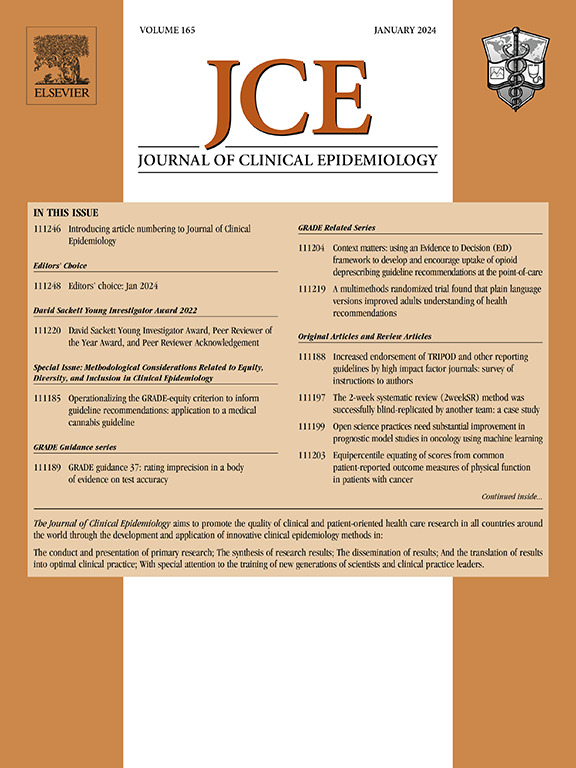联合模型为临床试验中患者报告结果的纵向评估提供依据:大腹部手术限制性输液疗法与自由输液疗法(RELIEF)随机对照试验的模拟研究与二次分析》(A Simulation Study and Secondary Analysis of the Restrictive versus Liberal Fluid Therapy for Major Abdominal Surgery (RELIEF) Randomized Controlled Trial)。
IF 7.3
2区 医学
Q1 HEALTH CARE SCIENCES & SERVICES
引用次数: 0
摘要
目的:评估联合模型在分析患者报告终点时的实用性:在分析随机对照试验中患者报告的终点时,如果患者在随访过程中死亡,则会出现剔除,因此要评估联合模型的实用性:本研究由两部分组成:首先,我们重新分析了之前发表的一项随机对照试验("RELIEF "试验)的数据,该试验比较了腹盆腔大手术后 24 小时内的两种输液方案。在该试验中,患者报告的残疾情况在手术前后的多个时间点进行了测量。接下来,我们进行了一项模拟研究,在九种治疗结果情景下共同模拟患者报告的残疾和存活率,与 "RELIEF "试验类似。在这两部分中,我们将联合模型分析与线性混合效应模型进行了比较,后者结合了几种处理纵向缺失的传统方法之一:可用数据分析、完整病例分析、最后观察结果结转和最坏情况假设:结果:在第一部分中,联合模型显示术后1、3、6和12个月患者报告的残疾情况没有组间差异。最坏情况假设方法始终导致与联合模型估计值的最大偏差,尽管在这种特殊情况下,没有任何一种方法能实质性地改变研究结论。在第二部分中,模拟结果显示,在所有治疗结果情况下,联合模型都能对患者报告的残疾程度做出无偏见的估计。同样,采用基于所有可用数据的方法(即依靠最大似然估计法处理缺失率)得出的残疾估计值接近模拟值,尽管在某些情况下略有偏差。最后观察结果结转法反映了联合模型的估计值,除非治疗对患者报告的残疾有非空效应。最坏情况分析导致偏差较大,这在治疗对存活率有较大影响时尤为明显。完整病例分析在所有情况下都会导致高偏差:结论:在采用患者报告结果作为终点之一的随机试验中,联合模型可以解决与死亡相关的信息缺失造成的偏差。基于所有可用数据的缺失处理方法似乎是联合模型的合理替代方案,在某些模拟方案中仅存在轻微偏差。本文章由计算机程序翻译,如有差异,请以英文原文为准。
Joint models inform the longitudinal assessment of patient-reported outcomes in clinical trials: a simulation study and secondary analysis of the restrictive Vs. liberal fluid therapy for major abdominal surgery (RELIEF) randomized controlled trial
Objectives
Evaluate the utility of a joint model when analysing a patient-reported endpoint as part of a randomized controlled trial (RCT) in which censoring occurs when patients die during follow-up.
Study Design and Setting
The present study comprises two parts as follows: first we reanalyzed data from a previously published RCT comparing two fluid regimens in the first 24 hours of major abdomino-pelvic surgery ('Restrictive versus Liberal Fluid Therapy for Major Abdominal Surgery [RELIEF]' trial). In this trial, patient-reported disability was measured at multiple timepoints before and after surgery. Next, we conducted a simulation study to jointly emulate patient-reported disability and survival, similar to the RELIEF trial, under nine treatment-outcome scenarios. In both parts, we compared a joint model analysis to a linear mixed-effect model combined with one of the several traditional methods of handling longitudinal missingness as follows: available data analysis, complete case analysis, last observation carried forward, and worst-case assumption.
Results
In part one, the joint model revealed no between-group differences in patient-reported disability at 1, 3, 6, and 12 months after surgery. The worst-case approach consistently resulted in the largest deviation from the joint model estimates, although in this particular setting none of the approaches materially changed the study's conclusions. In part two, the simulations revealed that across all treatment-outcome scenarios, the joint model expectedly produced unbiased estimates of patient-reported disability. Similarly, employing an approach based on all available data (ie, relying on the maximum likelihood estimator for handling missingness) yielded disability estimates close to the simulated values, albeit with slight bias across some scenarios. The last observation carried forward approach that mirrored the joint model's estimates except when the treatment had a nonnull effect on patient-reported disability. The worst-case analysis resulted in high bias, which was particularly evident when the treatment had a large effect on survival. The complete case analysis resulted in high bias across all scenarios.
Conclusion
In randomized trials that employ a patient-reported outcome as one of their endpoints, a joint model can address bias arising from informative missingness related to death. Methods for handling missingness based on all available data appear to be a reasonable alternative to joint models, with only slight bias across some simulated scenarios.
Plain Language Summary
‘Patient-centered research’ focuses on outcomes that are prioritized by patients. This approach often involves asking patients to complete questionnaires about their health experiences. However, if a patient does not finish a study, dealing with their missing answers can pose significant challenges. Joint models are a recent statistical method that may help address this issue. In this study, we used joint models in a real-world clinical trial, and in a series of simulated trials, to determine how well they handle missing questionnaire data from patients. We found that joint models offer significant benefits over most traditional methods used to analyze clinical trials.
求助全文
通过发布文献求助,成功后即可免费获取论文全文。
去求助
来源期刊

Journal of Clinical Epidemiology
医学-公共卫生、环境卫生与职业卫生
CiteScore
12.00
自引率
6.90%
发文量
320
审稿时长
44 days
期刊介绍:
The Journal of Clinical Epidemiology strives to enhance the quality of clinical and patient-oriented healthcare research by advancing and applying innovative methods in conducting, presenting, synthesizing, disseminating, and translating research results into optimal clinical practice. Special emphasis is placed on training new generations of scientists and clinical practice leaders.
 求助内容:
求助内容: 应助结果提醒方式:
应助结果提醒方式:


